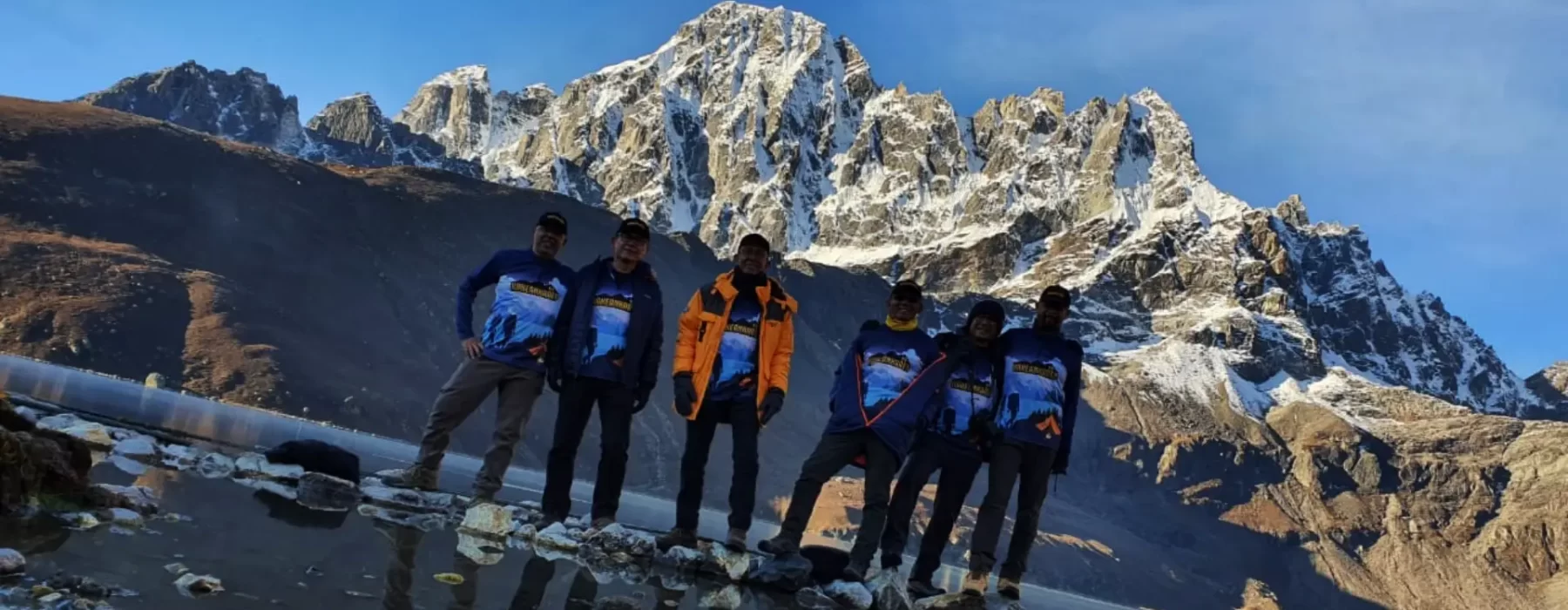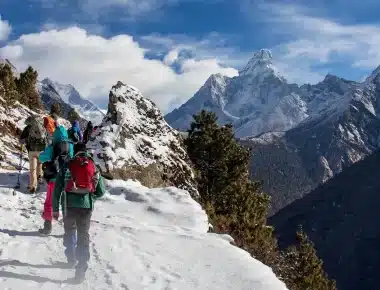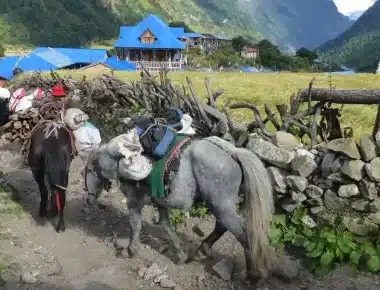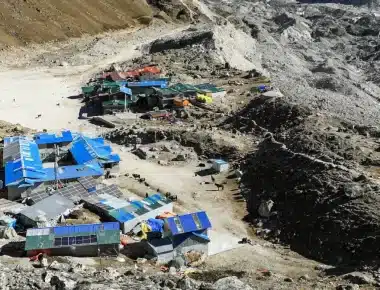Welcome to a tour across nature’s most gorgeous mountain wilderness. Go on an Everest Base Camp Trek via Gokyo Lakes to experience the real adventure of being in the mountains. While one gathers to discover melting ice as beautiful lakes, another brings the joy of being at the base of the top of the world, Mt. Everest.
Do you still believe you can’t see Gokyo Lakes and Everest Base Camp in one trip?
Say hello to the idealistic route of the Everest Base Camp Trek along the isolated paths via the Gokyo Lakes. Assemble your heart and mind to traverse off-the-beaten-track Sherpa routes as you explore Everest through the Gokyo Lakes Trek route.
This route is longer and less straightforward than the usual Everest Base Camp Trek, but it makes a clear loop around Gokyo Lake, Khumbu Glacier, Lobuche, etc., giving you access to less-traveled areas.

Two visitors facing towards blue water in Gokyo Lake
The stunning natural characteristics of the Everest Base Camp Trek via Gokyo Lakes include pristine air, a breathtaking backdrop of snow-capped mountains, blue lakes, and surrounding flora and fauna, local life, the glaring sun, and striking clouds. This serene location is a grandiose illustration of the gifts of life.
Besides, you get to enjoy a bird’s-eye view of the mountain’s size, grandeur, and many water bodies that have been protected. The tranquility comes to life throughout the entire walk to EBC with Gokyo Lakes.
Table of Contents
- Highlights of the Everest Base Camp Trek via Gokyo Lakes
- What is the best time for the Everest Base Camp Trek via Gokyo Lakes?
- How hard is Everest Base Camp Trek via Gokyo Lakes?
- Food and accommodation in Everest Base Camp Trek via Gokyo Lakes
- Equipment and gears for the Everest Base Camp Trek via Gokyo Lakes
- The Basic Itinerary for the Everest Base Camp Trek via Gokyo Lakes
- Reasons for joining the Everest Base Camp Trek via Gokyo Lakes
- Alternative Treks
- FAQ
Highlights of the Everest Base Camp Trek via Gokyo Lakes
One of the most common questions I usually receive is: What are the major highlights of the Everest Base Camp Trek via the Gokyo Lakes route? Here, I provide you with several gifts that inspire gratitude to Mother Nature.
- Thrilling sights of six emerald lakes of the Gokyo freshwater lake system of major six lakes: Thonak Cho (largest), Gokyo Cho (Dudh Pokhari), Thonak Cho, Kyajumba Cho, Ngojumba Cho, and Gyazumpa Cho.
- A beautiful sequence of turquoise lakes in the Gokyo valley with at least twenty high-altitude that will eventually join the well-known Everest Base Camp.
- Pristine Gokyo and associated wetlands of 7,700 ha (30.0 sq. mi.), a designated Ramsar site.
- Advancing the world’s majestic mountain map base with spectacular scenery, stunning trials with Cho La Pass (5,368 m)
- Soar into the landmarks of the Khumbu region with a rewarding Khumbu Icefall view.
- Spectacular vistas from such celebrated mountain peaks as Everest, Lhotse, Amadablam, Pumori, Nuptse, Mt. Cho Oyu, Makalu, and other eight-thousanders.
- Memorable adventures at the viewpoints like Gokyo Ri (5,357 m) and Kala Patthar (5,643 m), the highest point of this trek.
- Looming tents at the Everest Base Camp during the climbing season
- The picturesque Ngozumpa glacier (the longest glacier in Nepal) arises from Mt. Cho Oyu.
- Flight to the gorgeous scenery of Lukla (approximately 40 minutes) to the world’s highest altitude airport
- Colorful monasteries, prayer flags, Mani stones, and high suspension bridges, including Tengboche Monastery, the Khumbu region’s largest monastery.
- Amazing views of the Sherpa Capital, Namche Bazaar (also known as the gateway to Everest)
- Land into the Sagarmatha National Park—a UNESCO World Heritage Site to explore the wide range of incredible flora and fauna.
- It is a lifetime experience to visit the Edmund Hillary-funded schools and hospitals.
What is the best time for the Everest Base Camp Trek via Gokyo Lakes?
The tough yet rewarding Everest Base Camp with Gokyo Lakes journey has rocky roads, sharp descents, long climbs, and steep forward trails. Excluding travel time, the time spent trekking each day is anywhere from 5 to 7 hours.
Nature has very volatile behavior. That’s why the weather predictions are not as expected, as the weather changes frequently at high altitudes. Although the locals and trekking professionals travel throughout the year, spring and autumn are favorable seasons to trek. March-May and October-November can be the best months.
The weather is a significant aspect of a successful trek to walk through the trails and the opportunity to watch out for the mountain view. Here’s what the weather and temperature look like during each month along the trekking route of the Everest Base Camp Trek via Gokyo Lakes.
Winter
The winter months of Nepal are December, January, and February. The temperature during this period ranges from 15°C to -15°C. Since it’s the coldest season of the year, the region experiences heavy snowfalls that make the terrain treacherous and the weather unfavorable for hiking. Trekkers are therefore at risk.
Trekking is possible, however, only if one loves adventure. If you are allergic to colds, avoid this time of year.
Summer
Summer is often included in the rainy season, which comprises the months from July to August. Rainy weather causes hardship below 3500 meters. Mainly in locations like the Lukla Airport and the surrounding area. The monsoon brings overcast weather. So, the likelihood of the flights being canceled increases. It also has some benefits. Rainy summer can provide the best views of the rivers, lakes, and waterfalls along the trail leading to Everest Base Camp via Gokyo lakes.
During this season, a 27°C to 5°C temperature range is present. If you like challenges and adventure, this season is also suitable. However, you should be ready to take a helicopter flight instead of Lukla flights during cloudy days.

A visitor posing for a photo standing in the Gokyo Lake.
Spring
One of the best times of the year to hike at Everest Base Camp is in the spring. The Himalayan hills are breathtakingly beautiful at this time of year. As the temperature rises from 18 °C to 12 °C, all the plants and animals bloom.
The monsoon season doesn’t start until mid-August; it lasts from May through June when temperatures range from 25 °C to -5 °C. The climate is more pleasant, warmer, and ideal for trekking. Therefore, you can refer to spring as the best time to hike to Everest Base Camp with Gokyo Lakes.
Autumn
In the Himalayas, the weather can change quickly. September through December is when the autumnal temperature ranges. The nights are cooler. You experience snow. However, it is a time of choice for many and a chance to enjoy the lovely weather. The first few months are cool and suitable for trekking. But, during the chilly month of December, the snow covers the route, making it difficult to walk.
20°C to 5°C is the optimum range of daytime temperatures during September and October. Thus, it’s a suitable time for hiking along the trail to Everest Base Camp via Gokyo Lakes.
As a result, a lot of hikers also choose this time because of its ideal hiking environment. Along with that, as the monsoon season draws to a close, one may also have the chance to take part in the major Nepali festivals, Dashain and Tihar.
How hard is Everest Base Camp Trek via Gokyo Lakes?
Although the traditional Everest trip is simple, the Gokyo Lakes variant may be more challenging. The hiking path is rough and uneven, and the ascent is steeper than it would be if it were gradual. Thus, following the Everest Base Camp Trek via Gokyo Lakes itinerary isn’t as easy as it sounds. It’s a strenuous trek to trek grade and involves 6-7 hours of walking each day. The grade depends on the physical fitness, the season, and the trekking experience as well.
The elevation goes up to the maximum altitude of 5550 meters at Kala Patthar. On each day, you will gain 300 m to 900 m of altitude. Thus, altitude sickness is also equally a threat to trekkers.
The weather is mild at lower elevations. But as you travel higher, the winds become snowy and frozen, increasing the risk of cold. Though warm clothing and exercise can help keep the body at a constant temperature by absorbing body heat.
Despite the challenges, it’s a beautiful trek and can be done by every age group above 13 and below 75 with prior hiking experience.
A person who is in good physical and mental health will benefit the most. For anyone, regardless of age, with heart or lung illness, this walk is not advised. While traveling along the unconventional route, mental and physical preparation are equally crucial. Without adequate mental preparation, the subsequent step may seem quite difficult.
To prevent perilous conditions on the trek, avoid all monsoon, summer, and winter months other than spring and autumn. It is preferable to have a light backpack or use a porter to avoid knee pressure during the steep ascent.
Food and accommodation in Everest Base Camp Trek via Gokyo Lakes
Typically, there are three different lodgings available:
- Inexpensive teahouses
- Moderately priced eco-lodges
- Expensive guesthouses
Many budgets can find a hotel in Kathmandu. In Namche Bazaar, there are several Wi-Fi-connected cafes, restaurants, hotels, and gift and equipment shops. There are options for standard meals (breakfast, lunch, and dinner) and overnight accommodation.
Standard accommodation is available for lodge stays depending on the individual schedule. Simply select the one that works for you.
During the walk, hot showers and Wi-Fi will be accessible, but at an additional cost. Although there aren’t as many food options as in the capital, you can still get good meals while you’re there. This comprises a variety of carbs, proteins, and other nutrients for food. It will also have indigenous recipes for the flavor to support walking in some of the world’s highest terrain.
Kindly note that the diversity declines with elevation. For hygienic and health reasons, we don’t recommend having animal-based goods like dairy, alcohol, caffeinated drinks, and meat. Instead, you can choose to have vegetarian dishes from Western, Asian, and indigenous food options.
Equipment and gears for the Everest Base Camp Trek via Gokyo Lakes
The Everest Base Camp Trek via Gokyo Lakes requires a significant amount of pre-trip planning. These include some fundamental advice covering anything from personal safety to accessories and additional goods that can be purchased in Kathmandu. It’s wise to preserve necessities while considering the lightness in weight as one mentally prepares to explore and step on this new voyage of the adventuresome route. In the event of a necessity or requirement, porters will also be available.
As crucial as preparing the body for physical endurance is having the right amount of clothing on. It’s important to wear comfortable clothing and merino layers. An unavoidable weapon to combat the terrible weather can be a down jacket and sleeping bag, which can withstand temperatures as low as -20 degrees centigrade. For personal protection, you’ll need smaller basics, such as gloves, woolen caps, and other gear supplies for the Everest Base Camp Trek.
A sun hat, a hat with a wide brim, a winter hat, a cap, or a scarf are excellent choices for protecting your face from UV rays during the day. When crossing the path, wear sunscreen, face and body wipes, and UV-protective sunglasses. Alike, lightweight gloves are one of the essential requirements, as the climate expects.
To protect the hands from the chilly weather, heavy winter gloves are another option. Similar, warm clothing that covers the body effectively includes long-sleeved hiking shirts, some fleece jackets, inners, hooded raincoats, waterproof jackets, and shoes.
Other optional requirements for consular access include a cell phone, watch, money, camera, first aid kit, photocopies of a passport, PP-sized pictures, and binoculars.
Next, you need the perfect footwear. Bring a pair of hiking boots that are warm and light and provide excellent ankle support. They should also have breathable, waterproof, solid bottoms. To avoid blisters and stiffness, always remember to take a break from wearing your hiking boots.
Plus, bring a headlight with extra batteries, just in case. Thermo bottles, towels, nail clippers, biodegradable bar soaps, toothbrushes, toothpaste, dental floss, deodorants, and sleeping bags are additional necessary items that can be carried in a regular daypack.

Small lakes in Gokyo Valley
The Basic Itinerary for the Everest Base Camp Trek via Gokyo Lakes
Below is the 15-day itinerary for the Everest Base Camp Trek via Gokyo Lakes.
- Day 1: Arrive in Kathmandu (1,400m/4,593ft), Nepal’s historical capital. (Start the preparation process. We advise you to stay near Thamel.)
- Day 2: Take a 35-minute flight to Lukla (2,850m/9,350ft). Then, trek to Phakding (2650m/8562ft) via several Buddhist sites.
- Day 3: Trek from Phakding (2,650 m/8,562 ft) to Namche Bazaar (3,440 m/11,285 ft) for 10.7 kilometers. (Leads to Sagarmatha National Park.)
- Day 4: Acclimatization in Namche Bazaar (3,440 m/11,286 ft) (A short climb to the Everest View Hotel can provide breathtaking views of the surrounding peaks.)
- Day 5: Trek to Dole (4,038m/13,248.03ft): 11.5 km, 5-6 hours, 500 m elevation gain ascending the Dudh Koshi valley to the northwest.
- Day 6: Trek to Machhermo (4,470m/14,665ft): 5.3km, 3-4 hours, 500m ascent (Watch out for a few of the yaks.)
- Day 7: Trek to Gokyo Lakes (4,790m/15,715ft) trek: After 3–4 hours (7 km) of hiking, you will arrive in Gokyo village, where you will spend the night, after the third lake.
- Day 8: Hike to Gokyo Ri (6-7 hours) before continuing to Thagnak (4,680m/15,354ft). (It is an 8-kilometer trek where you cross the Ngozumpa glacier and get spectacular views.)
- Day 9: Trek to Lobuche village (4,910m/16,109ft) and through the Chola Pass (7–8 hours) (Travel through Cho La, one of the “Three Passes.”)
- Day 10: Hike for approximately 7-8 hours (12 miles) to Gorak Shep (5,140m/16,864ft) and then to EBC (5,364m/17,598ft). (Viewing of the Khumbu icefall.)
- Day 11: Hike to Kala Patthar (5,550m/18,209ft) and trek to Pheriche (4,240m/13,911ft)—approximately 5 to 6 hours (12 km trek). (Get stunning views of Mount Everest and the other summits. That afternoon, make your way to Dingboche by using the traditional path.)
- Day 12: Trek to Namche (3,440 m/11,286 ft): six to seven hours (19 km). (Return to Namche Bazaar via Tengboche, descending the rhododendron-covered slopes.)
- Day 13: Trek to Lukla (2,840 m/9,318 ft): 18.5 km, 6-7 hours of trekking (Trek across the Dudh Koshi valley to Lukla).
- Day 14: Fly to Kathmandu.
- Day 15: Departure from Kathmandu.
Reasons for joining the Everest Base Camp Trek via Gokyo Lakes
You probably don’t need any obvious reasons to travel to Everest. The region possesses many adventures and high mountains. But for your sake and to give you a simple reason to choose this streak instead of others, here I present to you the 17 major reasons to choose this trek.
- A unique and adventurous journey through the highlands.
- It serves the greatest views in the Everest region.
- The usual path to Everest Base Camp can become very crowded with trekkers and climbers at various seasons of the year. So, this route will give you more room for adventure and more exploration time.
- Stroll around Machhermo, a Sherpa summer settlement and pasture that is encircled by snow-capped mountains.
- Look at the memorial built to remember people who perished in this tough environment.
- Set foot in Gorak Shep, a tiny town that rests on the edge of a frozen lakebed and is the home of the Sherpa people, who are well-known for their prowess as mountaineers and guides.
- Travel by several yak pastures and the Ngozumpa Glacier
- View the sunrise over Mount Everest and other Himalayan peaks by going to Kala Patthar’s viewpoint (5,554m).
- Immerse yourself in Dudh Pokhari’s blue lake, which is a sacred spot for both Buddhists and Hindus.
- Syangboche is the destination for the traditional Everest route, but for the Everest Base Camp Trek with Gokyo Lakes (4,790m), the road goes toward Dole and Machhermo, which passes through Gokyo Lakes in the northwest. This gives you more time to spend time with Sherpa locals.
- Catching up with Mt. Ama Dablam, Mt. Cho Oyu (the fifth tallest mountain in the world), and Mt. Khumbila’s breathtaking vistas. Along the journey, pine and rhododendron forests appear.
- Explore as much of Sagarmatha National Park’s UNESCO World Heritage Site as possible.
- Onboard, the flight to and from Lukla is scenic and exciting.
- Direct contact with local people understanding their traditions and customs
- Reach the Gokyo Valley and a mountain pass at high altitudes like Cho La Pass (5,420 m), and ultimately Everest Base Camp (5,380 m).
- Golden Brahminy ducks surround five lakes in frozen Gokyo Valley in March and April.
- Trekking becomes more luxurious on the route to Gokyo Village and Gokyo-Ri (5,357 m). You can use these locations for both relaxation and acclimatization before climbing higher.
Alternative Treks
Apart from the Everest Base Camp Trek via Gokyo Lakes, other Mt. Everest tours available include:
Everest Base Camp-Three Passes Trek (15–25 days) (This includes crossing the highest passes in the mountain region like Cho La Pass, Kong Ma La, and Renjo La.)
Standard Everest Base Camp Trek (11–13 days) (Doesn’t include a trip to Gokyo Valley.)
Everest Panorama View Trek (7–10 days) (Just trek to the Everest View Hotel to witness panoramic views of the Khumbu mountains.)
FAQ
Can altitude sickness affect me?
The trek’s schedule is planned to give the body adequate time to adjust to the high elevations. You should be alright if you follow the instructions and take your time climbing. It is important to educate yourself about the symptoms and various varieties of altitude sickness because it can affect anyone, regardless of age or physical condition. Allow time for acclimatization and altitude sickness, and get yourself psychologically and physically ready.
Is acclimatization necessary while on the Everest Base Camp with Gokyo Lake Trek?
Acclimatization is very important while ascending high altitudes to limit altitude sickness. It gives your body enough time to adapt to a new environment. While transcending the Everest Base Camp via Gokyo Lake, two places can be important for acclimatization: Namche Bazaar—the Sherpa Capital, and Gokyo Lake.
If acclimatization days aren’t included in the itinerary, then you may also be the victim of altitude sickness. With this, it is important to find intensive care immediately or to descend as soon as possible.
Which age group can try the Gokyo Lakes to Everest Base Camp Trek?
Age is not a relative factor for this expedition. Instead, having the physical stamina and mental fortitude to engage in more physically demanding tasks will be sufficient. However, because they are biologically more developed, adults who are active hikers enjoy their travels more.
Is it safe to hike via Gokyo Lakes on the Everest Base Camp Trek?
Hiking via Gokyo Lakes is hard because it is not the conventional route to Everest Base Camp, but it is safe. This path has an equal number of hikers as the traditional one does. Hiring a guide and porters can be a smart alternative if you feel insecure. Avoid traveling during the off-season and plan your trip for March through May or September through October.








0 Comments